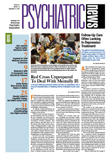Genetic linkage analysis of families with autism appears to strengthen the case for a strong link to one gene and weaker links to several others.
And while a complete understanding of the genetic underpinnings of autism—such as might provide the means for predictive testing—is still at least several years away, the new findings will more immediately aid in advancing an understanding of the pathophysiology of the disorder.
So say the authors of a report titled “Evidence for Multiple Loci From a Genome Scan of Autism Kindreds,” which appeared in the August 1 advance online edition of Molecular Psychiatry.
“We really need to understand autism at a cellular and molecular level,” lead author Gerard Schellenberg, Ph.D., told Psychiatric News. “Today we are only grasping at straws. But if we find some of the genes involved, then we know where we can start looking for the molecular and cellular pathways. That's really the payoff from these findings.”
He is associate director for research at the Geriatric Research Education and Clinical Center at the Veterans Affairs Puget Sound Health Care System, Seattle Division.
Schellenberg said the analysis found strong evidence for genetic linkage to autism on chromosome 7q, at a location that coincides with that found in several other studies. The robustness of the finding and its confirmation by other linkage analyses lends strong credibility to the hypothesis that 7q is involved in the disorder.
But the study also identified several other genes with weaker but still important links to the disease, and Schellenberg emphasized that the study confirms once more that autism—like other neuropsychiatric and mental disorders—is complex, involving multiple genes.
Moreover, the study findings suggest that autism may be several genetic diseases with different genes that may be specific to autism as it appears differentially in boys and girls, in late- and early-onset autism, and in the different behavioral domains of autism.
For instance, Schellenberg and colleagues used measures of language acquisition—the age at which a child with autism first spoke a word or a phrase—and then identified a gene location on chromosome 9 that appears to be at least weakly identified with this particular behavioral domain. (The three domains of autism are failure to connect socially, delayed language acquisition, and repetitive stereotypic interactions.)
“Within those three domains are subdomains that can be further divided out,” Schellenberg said. “One of our ideas is that there are different genes that contribute to different domains. You put all those domains together and the genes together, and you have autism.”
Similarly, when the sample of families was stratified into those with only males having autism, analysis suggested a link to chromosome 11. Families having only females with autism were linked to chromosome 4.
These findings suggest the possibility that there is a gender-specific form of autism that has a unique constellation of genes. “They probably overlap in terms of what complement of genes is necessary,” Schellenberg said. “The same three or four may be necessary, plus one that is specific to gender.”
The same differential genetics were found when the researchers scanned families with late-onset and early-onset autism. Modest links were found between “regression” autism—in which a child may acquire normal language by age 3 but regress thereafter—and chromosome 10; more significant links were found between the early-onset form of the disorder and chromosome 3.
“We think there may be some of the same genes involved in both types,” Schellenberg said. Nonetheless, “there may be some that are specific to regression.”
In the study genome-wide scans were performed on 222 families who identified themselves as having two or more children with autism, pervasive developmental disorder, or autistic spectrum disorder.
“We really need to understand autism at a cellular and molecular level.”
The families were recruited through five institutions (the University of Washington, the University of Pittsburgh, the University of California at Irvine, the University of Rochester, and the University of Utah), and diagnosis was based on the National Institute of Child Health and Development Collaborative Programs of Excellence in Autism diagnostic criteria.
Schellenberg expressed optimism about the advancing understanding of autism and the role of genetics.
“I think genetics are so important for getting at the underlying cause,” he said. “And if there is going to be a pharmacologic treatment, you need a molecular target. If you know the molecular pathway of the disorder, you have a much better chance of designing a drug that will be effective.”
An abstract of “Evidence for Multiple Loci From a Genome Scan of Autism Kindreds” is posted online at<www.nature.com/mp/journal/vaop/ncurrent/abs/4001874a.html>.▪
